2012年大学日语四级考试真题
- 格式:pdf
- 大小:1.86 MB
- 文档页数:11
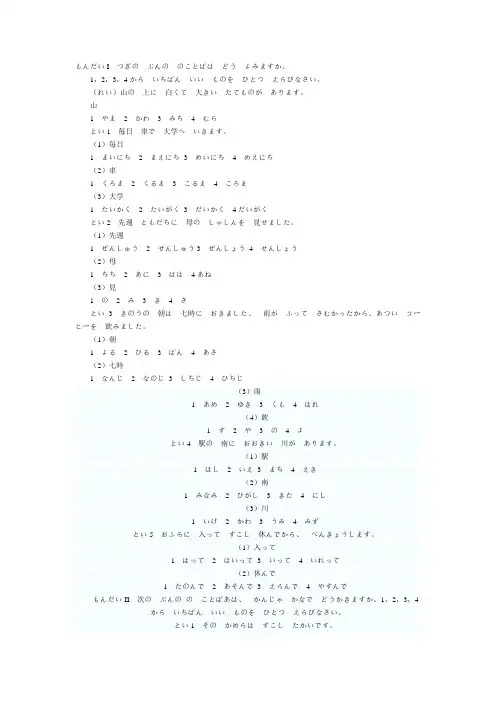
もんだいIつぎのぶんののことばはどうよみますか。
1,2,3,4からいちばんいいものをひとつえらびなさい。
(れい)山の上に白くて大きいたてものがあります。
山1やま2かわ3みち4むらとい1毎日車で大学へいきます。
(1)毎日1まいにち2まえにち3めいにち4めえにち(2)車1くろま2くるま3こるま4ころま(3)大学1たいかく2たいがく3だいかく4だいがくとい2先週ともだちに母のしゃしんを見せました。
(1)先週1ぜんしゅう2せんしゅう3ぜんしょう4せんしょう(2)母1ちち2あに3はは4あね(3)見1の2み3き4さとい3きのうの朝は七時におきました。
雨がふってさむかったから、あついコーヒーを飲みました。
(1)朝1よる2ひる3ばん4あさ(2)七時1なんじ2なのじ3しちじ4ひちじ来源:考试大-小语种考试(3)雨1あめ2ゆき3くも4はれ(4)飲1す2や3の4よとい4駅の南におおきい川があります。
(1)駅1はし2いえ3まち4えき(2)南1みなみ2ひがし3きた4にし(3)川1いけ2かわ3うみ4みずとい5おふろに入ってすこし休んでから、べんきょうします。
(1)入って1はって2はいって3いって4いれって(2)休んで1たのんで2あそんで3えらんで4やすんでもんだいII次のぶんののことばあは、かんじゃかなでどうかきますか。
1,2,3,4からいちばんいいものをひとつえらびなさい。
とい1そのかめらはすこしたかいです。
(1)すこし1示し2小い3少し4不し(2)たかい1長い2高い3多い4安いとい2ドアのみぎにでんきにすいっちがあります。
(1)みぎ1右2石3後4戸(2)でんき1電気2天気3電器4電機(3)すいっち1スイッテ2ネイッテ3スイッチ4ヌイッチとい3いつもここでしんぶんをかいます。
(1)しんぶん1新文2新分3新聞4新本(2)か1員2貿3貸4買とい4らいげつのむいかにともだちがきます。
来源:考试大-小语种考试责编:xyq 评论纠错(1)むいか1 八日2九日3三日4六日(2)き1来2木3気4行もんだいIII次のぶんの()のところになにをいれますか。
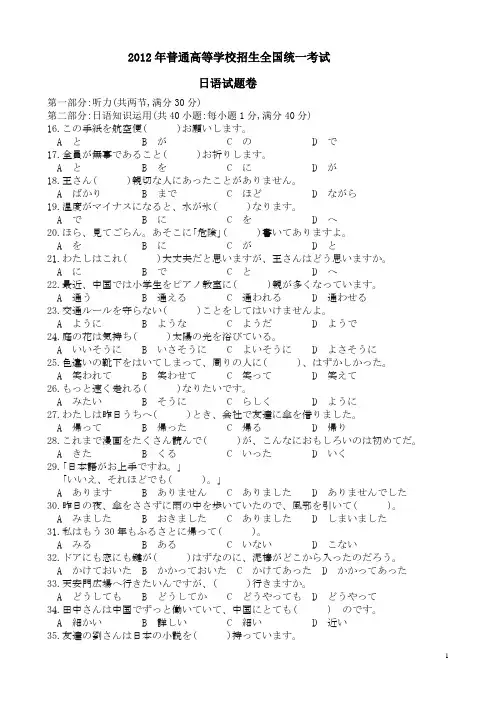
2012年普通高等学校招生全国统一考试日语试题卷第一部分:听力(共两节,满分30分)第二部分:日语知识运用(共40小题:每小题1分,满分40分)16.この手紙を航空便( )お願いします。
A とB がC のD で17.全員が無事であること( )お祈りします。
A とB をC にD が18.王さん( )親切な人にあったことがありません。
A ばかりB までC ほどD ながら19.温度がマイナスになると、水が氷( )なります。
A でB にC をD へ20.ほら、見てごらん。
あそこに「危険」( )書いてありますよ。
A をB にC がD と21.わたしはこれ( )大丈夫だと思いますが、王さんはどう思いますか。
A にB でC とD へ22.最近、中国では小学生をピアノ教室に( )親が多くなっています。
A 通うB 通えるC 通われるD 通わせる23.交通ルールを守らない( )ことをしてはいけませんよ。
A ようにB ようなC ようだD ようで24.庭の花は気持ち( )太陽の光を浴びている。
A いいそうにB いさそうにC よいそうにD よさそうに25.色違いの靴下をはいてしまって、周りの人に( )、はずかしかった。
A 笑われてB 笑わせてC 笑ってD 笑えて26.もっと速く走れる( )なりたいです。
A みたいB そうにC らしくD ように27.わたしは昨日うちへ( )とき、会社で友達に傘を借りました。
A 帰ってB 帰ったC 帰るD 帰り28.これまで漫画をたくさん読んで( )が、こんなにおもしろいのは初めてだ。
A きたB くるC いったD いく29.「日本語がお上手ですね。
」「いいえ、それほどでも( )。
」A ありますB ありませんC ありましたD ありませんでした30.昨日の夜、傘をささずに雨の中を歩いていたので、風邪を引いて( )。
A みましたB おきましたC ありましたD しまいました31.私はもう30年もふるさとに帰って( )。
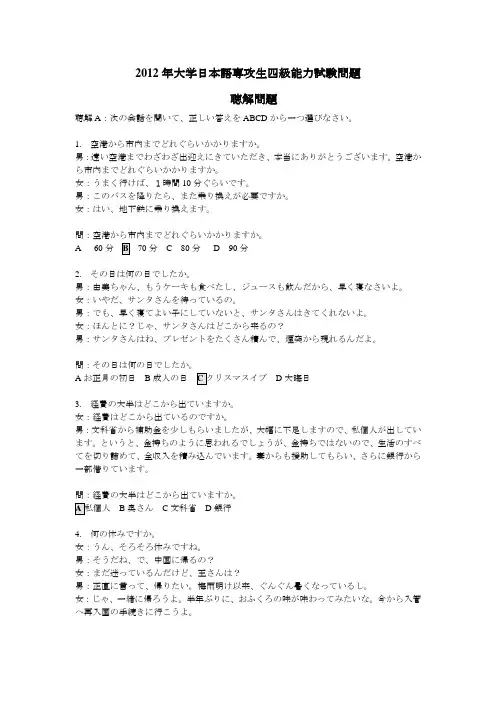
2012年大学日本語専攻生四級能力試験問題聴解問題聴解A:次の会話を聞いて、正しい答えをABCDから一つ選びなさい。
1.空港から市内までどれぐらいかかりますか。
男:遠い空港までわざわざ出迎えにきていただき、本当にありがとうございます。
空港から市内までどれぐらいかかりますか。
女:うまく行けば、1時間10分ぐらいです。
男:このバスを降りたら、また乗り換えが必要ですか。
女:はい、地下鉄に乗り換えます。
問:空港から市内までどれぐらいかかりますか。
A 60分70分C80分D90分2.その日は何の日でしたか。
男:由美ちゃん、もうケーキも食べたし、ジュースも飲んだから、早く寝なさいよ。
女:いやだ、サンタさんを待っているの。
男:でも、早く寝てよい子にしていないと、サンタさんはきてくれないよ。
女:ほんとに?じゃ、サンタさんはどこから来るの?男:サンタさんはね、プレゼントをたくさん積んで、煙突から現れるんだよ。
問:その日は何の日でしたか。
Aお正月の初日B成人の日D大晦日3.経費の大半はどこから出ていますか。
女:経費はどこから出ているのですか。
男:文科省から補助金を少しもらいましたが、大幅に不足しますので、私個人が出しています。
というと、金持ちのように思われるでしょうが、金持ちではないので、生活のすべてを切り詰めて、全収入を積み込んでいます。
妻からも援助してもらい、さらに銀行から一部借りています。
問:経費の大半はどこから出ていますか。
B奥さんC文科省D銀行4.何の休みですか。
女:うん、そろそろ休みですね。
男:そうだね、で、中国に帰るの?女:まだ迷っているんだけど、王さんは?男:正直に言って、帰りたい。
梅雨明け以来、ぐんぐん暑くなっているし。
女:じゃ、一緒に帰ろうよ。
半年ぶりに、おふくろの味が味わってみたいな。
今から入管へ再入国の手続きに行こうよ。
問:何の休みですか。
A 春休みC秋休みD冬休み5. 花見酒はどういう酒でしょうか。
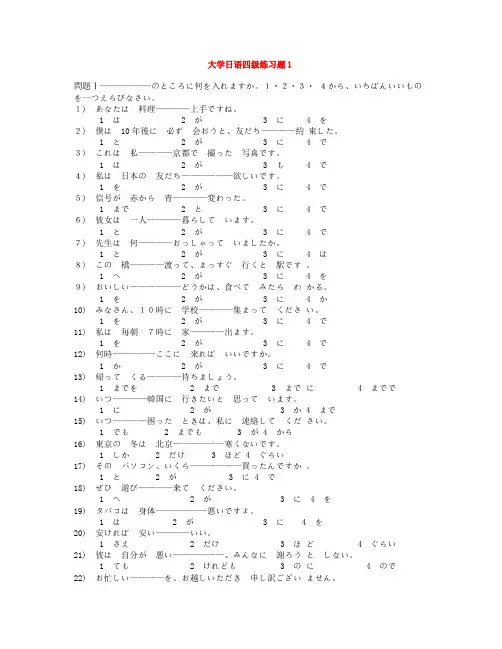
大学日语四级练习题1問題Ⅰ——————のところに何を入れますか。
1・2・3・4から、いちばんいいものを一つえらびなさい。
1) あなたは料理————上手ですね。
1 は2 が3 に4 を2) 僕は10年後に必ず会おうと、友だち————約束した。
1 と2 が3 に4 で3) これは私————京都で撮った写真です。
1 は2 が3 も4 で4) 私は日本の友だち——————欲しいです。
1 を2 が3 に4 で5) 信号が赤から青————変わった。
1 まで2 と3 に4 で6) 彼女は一人————暮らしています。
1 と2 が3 に4 で7) 先生は何————おっしゃっていましたか。
1 と2 が3 に4 は8) この橋————渡って、まっすぐ行くと駅です。
1 へ2 が3 に4 を9) おいしい——————どうかは、食べてみたらわかる。
1 を2 が3 に4 か10) みなさん、10時に学校————集まってください。
1 を2 が3 に4 で11) 私は毎朝7時に家————出ます。
1 を2 が3 に4 で12) 何時—————ここに来ればいいですか。
1 か2 が3 に4 で13) 帰ってくる————待ちましょう。
1 までを2 まで3 までに4 までで14) いつ————韓国に行きたいと思っています。
1 に2 が3 か4 まで15) いつ————困ったときは、私に連絡してください。
1 でも2 までも3 が4 から16) 東京の冬は北京——————寒くないです。
1 しか2 だけ3 ほど4 ぐらい17) そのパソコン、いくら——————買ったんですか。
1 と2 が3 に4 で18) ぜひ遊び————来てください。
1 へ2 が3 に4 を19) タバコは身体——————悪いですよ。
1 は2 が3 に4 を20) 安ければ安い————いい。
1 さえ2 だけ3 ほど4 ぐらい21) 彼は自分が悪い——————、みんなに謝ろうとしない。
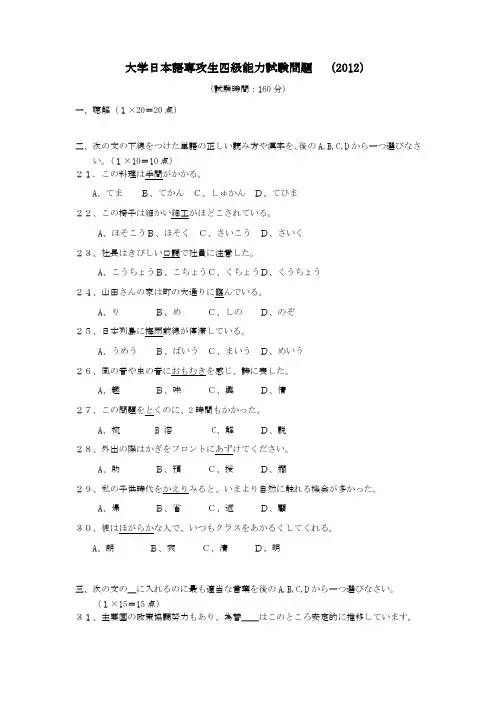
大学日本語専攻生四級能力試験問題(2012)(試験時間:160分)一、聴解(1×20=20点)二、次の文の下線をつけた単語の正しい読み方や漢字を、後のA,B,C,Dから一つ選びなさい。
(1×10=10点)21.この料理は手間がかかる。
A、てまB、てかんC、しゅかんD、てひま22、この椅子は細かい細工がほどこされている。
A、ほそこうB、ほそくC、さいこうD、さいく23、社長はきびしい口調で社員に注意した。
A、こうちょうB、こちょうC、くちょうD、くうちょう24、山田さんの家は町の大通りに臨んでいる。
A、りB、めC、しのD、のぞ25、日本列島に梅雨前線が停滞している。
A、うめうB、ばいうC、まいうD、めいう26、風の音や虫の音におもむきを感じ、詩に表した。
A、趣B、味C、興D、情27、この問題をとくのに、2時間もかかった。
A、梳 B 溶 C、解D、説28、外出の際はかぎをフロントにあずけてください。
A、助B、預C、授D、擱29、私の子供時代をかえりみると、いまより自然に触れる機会が多かった。
A、帰B、省C、返D、顧30、彼はほがらかな人で、いつもクラスをあかるくしてくれる。
A、朗B、爽C、清D、明三、次の文の_に入れるのに最も適当な言葉を後のA,B,C,Dから一つ選びなさい。
(1×15=15点)31、主要国の政策協調努力もあり、為替__はこのところ安定的に推移しています。
A、市場B、売場C、相場D、立場32、褒められたり__を言われたりしたことを人間はなかなか忘れないものだ。
A、利口B、無口C、悪口D、閉口33、うちの__は、ミステリー小説を創作する集まりとして、雑誌の読者欄などに紹介文を出して会員を募集しています。
A 、サークルB、サービスC、スピーチD、チーム34、どんな本かというと、算数の計算力を付けるために使用する学習用__を一冊にまとめたものです。
A、パターンB、プランC、プリントD、ベテラン35、昼前に若い一人の男が来て、兎を__買ってくれという。
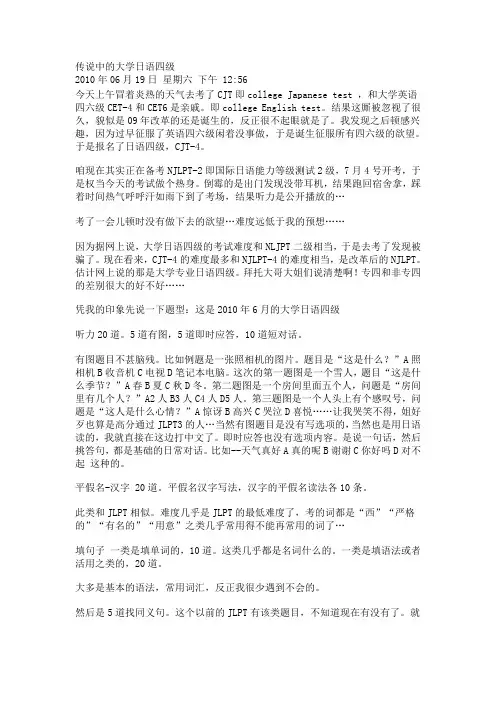
传说中的大学日语四级2010年06月19日星期六下午 12:56今天上午冒着炎热的天气去考了CJT即college Japanese test ,和大学英语四六级CET-4和CET6是亲戚。
即college English test。
结果这厮被忽视了很久,貌似是09年改革的还是诞生的,反正很不起眼就是了。
我发现之后顿感兴趣,因为过早征服了英语四六级闲着没事做,于是诞生征服所有四六级的欲望。
于是报名了日语四级,CJT-4。
咱现在其实正在备考NJLPT-2即国际日语能力等级测试2级,7月4号开考,于是权当今天的考试做个热身。
倒霉的是出门发现没带耳机,结果跑回宿舍拿,踩着时间热气呼呼汗如雨下到了考场,结果听力是公开播放的…考了一会儿顿时没有做下去的欲望…难度远低于我的预想……因为据网上说,大学日语四级的考试难度和NLJPT二级相当,于是去考了发现被骗了。
现在看来,CJT-4的难度最多和NJLPT-4的难度相当,是改革后的NJLPT。
估计网上说的那是大学专业日语四级。
拜托大哥大姐们说清楚啊!专四和非专四的差别很大的好不好……凭我的印象先说一下题型:这是2010年6月的大学日语四级听力20道。
5道有图,5道即时应答,10道短对话。
有图题目不甚脑残。
比如例题是一张照相机的图片。
题目是“这是什么?”A照相机B收音机C电视D笔记本电脑。
这次的第一题图是一个雪人,题目“这是什么季节?”A春B夏C秋D冬。
第二题图是一个房间里面五个人,问题是“房间里有几个人?”A2人B3人C4人D5人。
第三题图是一个人头上有个感叹号,问题是“这人是什么心情?”A惊讶B高兴C哭泣D喜悦……让我哭笑不得,姐好歹也算是高分通过JLPT3的人…当然有图题目是没有写选项的,当然也是用日语读的,我就直接在这边打中文了。
即时应答也没有选项内容。
是说一句话,然后挑答句,都是基础的日常对话。
比如--天气真好A真的呢B谢谢C你好吗D对不起这种的。
平假名-汉字 20道。
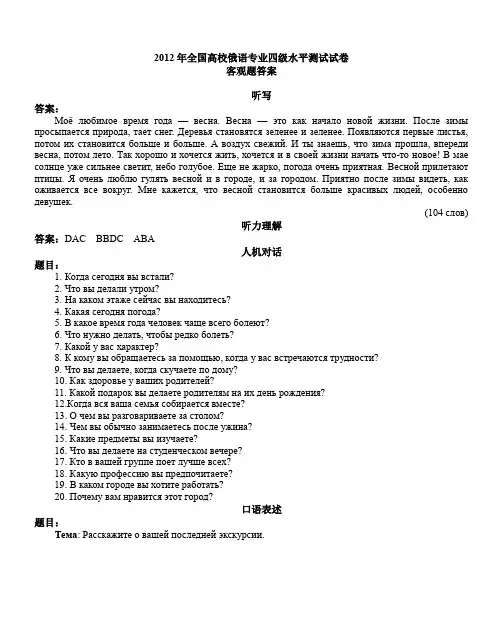
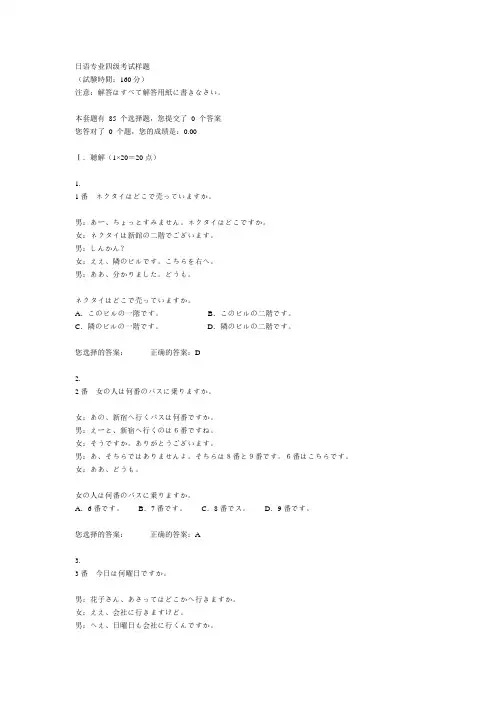
日语专业四级考试样题(試験時間:160分)注意:解答はすべて解答用紙に書きなさい。
本套题有85 个选择题,您提交了0 个答案您答对了0 个题,您的成绩是:0.00Ⅰ.聴解(1×20=20点)1.1番ネクタイはどこで売っていますか。
男:あー、ちょっとすみません。
ネクタイはどこですか。
女:ネクタイは新館の二階でございます。
男:しんかん?女:ええ、隣のビルです。
こちらを右へ。
男:ああ、分かりました。
どうも。
ネクタイはどこで売っていますか。
A.このビルの一階です。
B.このビルの二階です。
C.隣のビルの一階です。
D.隣のビルの二階です。
您选择的答案:正确的答案:D2.2番女の人は何番のバスに乗りますか。
女:あの、新宿へ行くバスは何番ですか。
男:えーと、新宿へ行くのは6番ですね。
女:そうですか。
ありがとうございます。
男:あ、そちらではありませんよ。
そちらは8番と9番です。
6番はこちらです。
女:ああ、どうも。
女の人は何番のバスに乗りますか。
A.6番です。
B.7番です。
C.8番でス。
D.9番です。
您选择的答案:正确的答案:A3.3番今日は何曜日ですか。
男:花子さん、あさってはどこかへ行きますか。
女:ええ、会社に行きますけど。
男:へえ、日曜日も会社に行くんですか。
女:いいえ、あさっては土曜日ですよ。
男:あれ、今日は金曜日でしょう。
女:いいえ、違いますよ。
男:あ、そうか。
今日は何曜日ですか。
A.木曜日です。
B.金曜日です。
C.土曜日です。
D.日曜日です。
您选择的答案:正确的答案:A4.4番男の人は昨日何をしましたか。
女:小林さん、昨日何をしましたか。
男:本を読んでいました。
女:じゃあ、うちにいたんですか。
男:いいえ。
女:あ、じゃあ、図書館?男:いいえ、天気がよかったから公園で。
女:ああ、いいですね。
男の人は昨日何をしましたか。
A.うちにいました。
B.公園で遊びました。
C.図書館に行きました。
D.外で本を読みました。
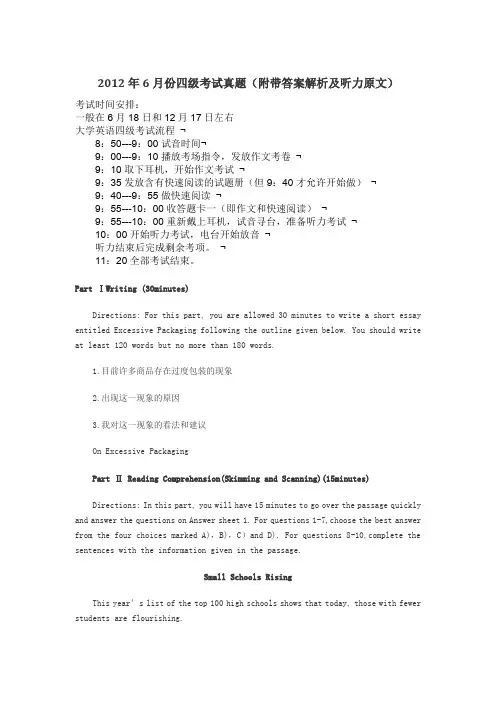
2012年6月份四级考试真题(附带答案解析及听力原文)考试时间安排:一般在6月18日和12月17日左右大学英语四级考试流程¬8:50---9:00试音时间¬9:00---9:10播放考场指令,发放作文考卷¬9:10取下耳机,开始作文考试¬9:35发放含有快速阅读的试题册(但9:40才允许开始做)¬9:40---9:55做快速阅读¬9:55---10:00收答题卡一(即作文和快速阅读)¬9:55---10:00重新戴上耳机,试音寻台,准备听力考试¬10:00开始听力考试,电台开始放音¬听力结束后完成剩余考项。
¬11:20全部考试结束。
Part ⅠWriting (30minutes)Directions: For this part, you are allowed 30 minutes to write a short essay entitled Excessive Packaging following the outline given below. You should write at least 120 words but no more than 180 words.1.目前许多商品存在过度包装的现象2.出现这一现象的原因3.我对这一现象的看法和建议On Excessive PackagingPart Ⅱ Reading Comprehension(Skimming and Scanning)(15minutes)Directions: In this part, you will have 15 minutes to go over the passage quickly and answer the questions on Answer sheet 1. For questions 1-7,choose the best answer from the four choices marked A),B),C)and D). For questions 8-10,complete the sentences with the information given in the passage.Small Schools RisingThis year’s list of the top 100 high schools shows that today, those with fewer students are flourishing.Fifty years ago, they were the latest thing in educational reform: big, modern, suburban high schools with students counted in the thousands. As baby boomers(二战后婴儿潮时期出生的人) came of high-school age, big schools promised economic efficiency. A greater choice of courses, and, of course, better football teams. Only years later did we understand the trade-offs this involved: the creation of excessive bureaucracies(官僚机构),the difficulty of forging personal connections between teachers and students.SAT scores began dropping in 1963;today,on average,30% of students do not complete high school in four years, a figure that rises to 50% in poor urban neighborhoods. While the emphasis on teaching to higher, test-driven standards as set in No Child Left Behind resulted in significantly better performance in elementary(and some middle)schools, high schools for a variety of reasons seemed to have made little progress.Size isn’t everything, but it does matter, and the past decade has seen a noticeable countertrend toward smaller schools. This has been due ,in part ,to the Bill and Melinda Gates Foundation, which has invested $1.8 billion in American high schools, helping to open about 1,000 small schools-most of them with about 400 kids each with an average enrollment of only 150 per grade, About 500 more are on the drawing board. Districts all over the country are taking notice, along with mayors in cities like New York, Chicago and San Diego. The movement includes independent public charter schools, such as No.1 BASIS in Tucson, with only 120 high-schoolers and 18 graduates this year. It embraces district-sanctioned magnet schools, such as the Talented and Gifted School, with 198 students, and the Science and Engineering Magnet,with383,which share a building in Dallas, as well as the City Honors School in Buffalo, N.Y., which grew out of volunteer evening seminars for students. And it includes alternative schools with students selected by lottery(抽签),such as H-B Woodlawn in Arlington, Va. And most noticeable of all, there is the phenomenon of large urban and suburban high schools that have split up into smaller units of a few hundred, generally housed in the same grounds that once boasted thousands of students all marching to the same band.Hillsdale High School in San Mateo, Calif, is one of those, ranking No.423—among the top 2% in the country—on Newsweek’s annual ranking of America’s top high schools. The success of small schools is apparent in the listings. Ten years ago, when the first Newsweek list based on college-level test participation was published, only three of the top 100 schools had graduating Classes smaller than 100 students. This year there are 22. Nearly 250 schools on the full ,Newsweek list of the top 5% of schools nationally had fewer than 200 graduates in 2007.Although many of Hillsdale’s students came from wealthy households, by the late 1990 average test scores were sliding and it had earned the unaffectionate nickname (绰号) “Hillsjail. ” Jeff Gilbert. A Hillsdale teacher who became principal last year, remembers sitting with other teachers watching students file out of a graduation ceremony and asking one another in astonishment, “How did that student graduate?”So in 2003 Hillsdale remade itself into three “houses,” romantically named Florence, Marrakech and Kyoto. Each of the 300 arriving ninth graders are randomly(随机地) assigned to one of the houses. Where they will keep the same four core subject teachers for two years, before moving on to another for 11th and 12th grades. The closeness this system cultivates is reinforced by the institution of “advisory”classes Teachers meet with students in groups of 25, five mornings a week, for open-ended discussions of everything from homework problems to bad Saturday-night dates. The advisers also meet with students privately and stay in touch with parents, so they are deeply invested in the students’ success.“We’re constantly talking about one another’s advisers,” says English teacher Chris Crockett. “If you hear that yours isn’t doing well in math, or see them sitting outside the dean’s office, it’s like a personal failure.” Along with the new structure came a more demanding academic program, the percentage of freshmen taking biology jumped from 17 to 95.“It was rough for some. But by senior year, two-thirds have moved up to physics,”says Gilbert “Our kids are coming to school in part because they know there are adults here who know them and care for them.”But not all schools show advances after downsizing, and it remains to be seen whether smaller schools will be a cure-all solution.The Newsweek list of top U.S. high schools was made this year, as in years past, according to a single metric, the proportion of students taking college-level exams. Over the years this system has come in for its share of criticism for its simplicity. But that is also its strength: it’s easy for readers to understand, and to do the arithmetic for their own schools if they’d like.Ranking schools is always controversial, and this year a group of 38 superintendents(地区教育主管)from five states wrote to ask that their schools be excluded from the calculation.“It is impossible to know which high schools are ‘the best’ in the nation, ”their letter read. in part. “Determining whether different schools do or don’t offer a high quality of education requires a look at man different measures, including students’ overall academic accomplishments and theirsubsequent performance in college. And taking into consideration the unique needs of their communities.”In the end, the superintendents agreed to provide the data we sought, which is, after all, public information. There is, in our view, no real dispute here, we are all seeking the same thing, which is schools that better serve our children and our nation by encouraging students to tackle tough subjects under the guidance of gifted teachers. And if we keep working toward that goal, someday, perhaps a list won’t be necessary.注意:此部分试题请在答卡1上作答.1. Fifty years ago. big. Modern. Suburban high schools were established in the hope of __________.A) ensuring no child is left behindB) increasing economic efficiencyC) improving students’ performance on SATD)providing good education for baby boomers2. What happened as a result of setting up big schools?A)Teachers’ workload increased.B)Students’ performance declined.C)Administration became centralized.D)Students focused more on test scores.3.What is said about the schools forded by the Bill and Melinda Gates foundation?A)They are usually magnet schools.B)They are often located in poor neighborhoods.C)They are popular with high-achieving students.D)They are mostly small in size.4.What is most noticeable about the current trend in high school education?A)Some large schools have split up into smaller ones.B)A great variety of schools have sprung up in urban and suburban areas.C)Many schools compete for the Bill and Melinda Gates Foundation funds.D)Students have to meet higher academic standards.5.Newsweek ranked high schools according to .A)their students’ academic achievementB)the number of their students admitted to collegeC)the size and number of their graduating classesD)their college-level test participation6.What can we learn about Hillsdale’s students in the late 1990s?A)They were made to study hard like prisoners.B)They called each other by unaffectionate nicknames.C)Most of them did not have any sense of discipline,D)Their school performance was getting worse.7.According to Jeff Gilbert, the “advisory” classes at Hillsdale were set up so that students could .A)tell their teachers what they did on weekendsB)experience a great deal of pleasure in learningC)maintain closer relationships with their teachersD)tackle the demanding biology and physics courses8. is still considered a strength of Newsweek’s school ranking system in spite of the criticism it receives.9.According to the 38 superintendents, to rank schools scientifically, it is necessary to use .10.To better serve the children and our nation, schools students totake .Part ⅢListening Comprehension (35minutes)Section ADirections: in this section you will hear 8 short conversations, one or more questions will be asked about what was said. Both the conversation and the questions will be spoken only once. After each question there will be a pause. During the pause, you must read the four choices marked A)、B)、C)and D)、and decide which is the best answer. Then mark the corresponding letter on Answer sheet 2 with a single line through the centre.注意:此部分试题请在答案卡2上作案。

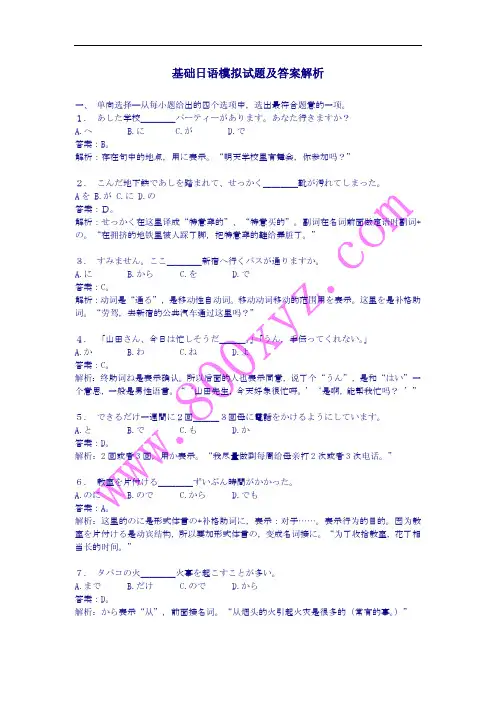
2012日语专业四级听力文字稿1.空港から市内までどれぐらいかかりますか遠い空港までわざわざ出迎えに来ていただき、本当にありがとうございます。
ここから市内までどのぐらいかかりますか?うまくいけば、一時間十分ぐらいです。
このバスを降りたら、また乗換えが必要ですか?はい、地下鉄に乗り換えます。
607080902.その日は何の日ですか?由美ちゃん、もうケーキを食べたし、ジュースを飲んだから、早く寝なさいよ。
いやだ、サンタさんを待っているの。
でも、早く寝てよい子にしないと、サンタさんは来てくれないよ。
ほんとに?じゃあ、サンタさんはどこから来るの?サンタさんはね、プレゼントをたくさんを積んで、煙突から現れるんだよ。
お正月の初日(しょにち)成人の日クリスマスイブ大晦日3.経費の大半(たいはん)どこから出ていますか?経費はどこから出ているのですか?文科省から補助金を少しもらいましたが、大幅に不足しますので、私個人が出しています。
というと、金持ちのようにと思われるでしょうが、金持ちではないので、生活のすべてを切り詰めて、?をつぎ込んでいます、妻からも援助してもらい、さらに、銀行から一部借りています。
私個人奥さん文科省銀行4.何の休みですか?もうそろそろ休みですね。
そうだね。
で、中国に帰るの?まだ迷っているんだけど、おんさんは?正直に言って、帰りたい。
梅雨明け以来、ぐんぐん暑くなっているし。
じゃあ、一緒に帰ろうよ。
半年振りに、おふくろの味を味わってみたいなあ。
今から入館へ再入国の手続きにいこうよ。
春休み夏休み明け休み冬休み5.花見酒(はなみざけ)はどういう酒でしょうか?花見酒って何でしょうか?お花見をしながら飲むお酒を花見酒というんですよ。
なるほど。
私は何か特別に上場された酒の一種かと思いました。
確かに、桜を見ながら、お酒を飲んだり、歌ったりするのは本当に楽しいですね。
それは、中国大陸から、稲作(いなさく)農業がもたらせたところから始まったそうです。
大学日語四級考試(試巻一)Ⅰ略Ⅱ文字と語彙セクション(20分間)一、次ののことばの読み方をそれぞれ「A」「B」「C」「D」から1つ選びなさい。
21、6月10日は私の誕生日です。
「A」とおか「B」よっか「C」ここのか「D」ようか22、西の空が赤くなりました。
「A」ひがし「B」にし「C」みなみ「D」きた23、日本のアニメは世界で有名です。
「A」ゆめ「B」ゆめい「C」ゆうめ「D」ゆうめい24、隣の教室は広いです。
「A」ひくい「B」せまい「C」ひろい「D」ふかい25、わたしの専攻は教育学です。
「A」せいこう「B」せんこう「C」せいこん「D」せんこん26、君も来れば 6人になる。
「A」か「B」き「C」く「D」こ27、残暑がまだ厳しい。
「A」きびしい「B」はげしい「C」さびしい「D」くるしい28、鯨は魚の仲間ではない。
「A」ちゅうま「B」なかま「C」ちゅうかん「D」なかかん29、気持ちが落ち着く場所を求めている。
「A」あつめている「B」はじめている「C」もとめている「D」たしかめている30、もうすぐ時間ですよ。
急いでください。
「A」きれいで「B」およいで「C」つないで「D」いそいで二、次ののことばの漢字を、それぞれ「A」「B」「C」「D」から 1つ選びなさい。
31、やまがきれいですね。
「A」山「B」土「C」川「D」畑32、荷物はつくえの横にあります。
「A」棚「B」机「C」車「D」柱33、やすければ買いましょう。
「A」高ければ「B」易しければ「C」低ければ「D」安ければ34、周りの人にめいわくをかけてはいけません。
「A」面倒「B」世話「C」迷惑「D」邪魔35、おやとして子どもに伝えておきたいことがあります。
「A」両親「B」母「C」大人「D」親36、彼のはっぴょうはすばらしかったです。
「A」発表「B」発展「C」発見「D」発明37、2つの単語の意味をくらべてみてください。
「A」調べて「B」並べて「C」述べて「D」比べて38、好きなものをえらんで、とっておいてください。
最新⼤学⽇语四级考试真题(1)⼤学⽇语四级考试真题⼤学⽇语四级考试样题试卷⼀⼀、将⾃⼰的学校名、姓名、准考证号写在答题卡和试卷⼆上。
考试结束后,将答题卡、试卷⼀、试卷⼆放在桌⼦上,待监考⼈员收卷后⽅可离开考场。
答题卡、试卷⼀、试卷⼆均不得带⾛。
⼆、仔细读懂题⽬的说明。
三、在120分钟内答完全部试题,不得拖延时间。
四、客观多项选择试题的答案⼀定要划在答题卡上,主观试题写在试卷⼆上。
凡写在试卷⼀上的答案⼀律作废。
五、客观多项选择试题只能选⼀个答案,多选作废。
选定答案后,⽤HB-2B铅笔按规定在相应字母的中部划⼀条横线。
正确的⽅法如下:[,] [,] ,;, [,]六、如果要改动答案,必须先⽤橡⽪擦去原来选定的答案。
七、主观试题⽤钢笔或圆珠笔书写。
聴解セクション,听解部分,,20分間,これから聞くテストを⾏います。
⼀、写真問題(图⽚题)写真か絵を⾒て質問に答えてください。
はじめに写真か絵について質問します。
その後で⽂を四つ⾔います。
その四つの中から正しい答えを⼀つ選んでください。
⽂は1回しか⾔いません。
まず例題をしてみましょう。
例題[,] [,] [;] [,](可先在试卷上选,然后划到答题卡上,下同。
)答えは,です。
このような問題は,から,まであります。
それでは、問題を始めます。
,,[,] [,] [;] [,],,[,] [,] [;] [,],,[,] [,] [;] [,],,[,] [,] [;] [,],,[,] [,] [;] [,]⼆、応答問題(应答题)始めに⼀⼈が短い⽂を⼀つ⾔う。
その後でもう⼀⼈がそれに答える。
正しい答えを[,][,][;][,]から、⼀つ選んでください。
⽂は⼀回しか⾔いない。
まず例題をしてみよう。
例題[,] [,] [;] [,]答えは,です。
このような問題は,から10まであります。
それでは、問題を始めます。
,,[,] [,] [;] [,];,[,] [,] [;] [,],,[,] [,] [;] [,],,[,] [,] [;] [,]10,[,] [,] [;] [,]三、会話問題(对话题)⼆⼈の会話を聞いて、質問に答えてください。